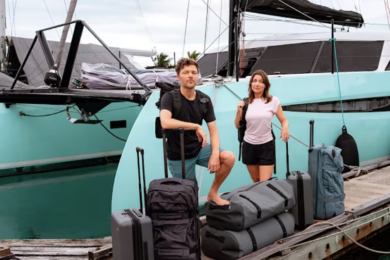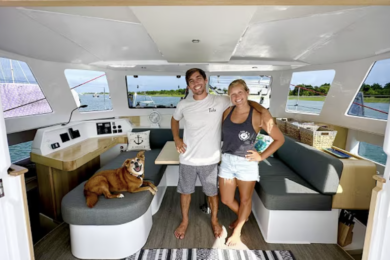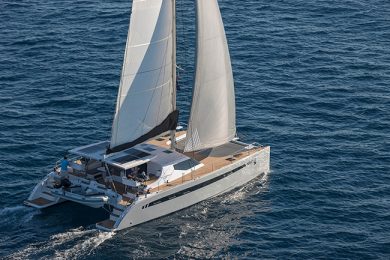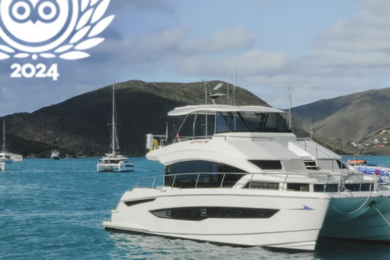Exploring Indonesia on an Antares 44 catamaran (Published Winter 2009)
Komodo Dragons, traditional weaving villages, orangutan and spider boats—we’ve seemingly stepped into a full-page spread of National Geographic. That’s what it felt like when we set sail from Darwin, Australia, into Indonesia’s archipelago.
With cruising permits and visas in hand, we left for the two-day sail from Darwin to Rinca Island—taking a brief respite at Ashmore Reef, a palm studded island oasis in a desert sea roughly halfway between Darwin and Indonesia. The lack of wind made for smooth seas and a wonderfully dull 700-mile passage to the Lehok Ginggo anchorage. Monkeys scurried from the rocks and into the trees as we took the dinghy to shore to explore the island’s infamous residents—Komodo Dragons. The first signs of the dragons are the tracks they leave behind as they lumber around in their chain mail-type skin. The trails make for good footing but were made by short critters, which means sticks and branches are constantly batted away from the waist up, and there is a lot of bending to duck under low branches.
We continued taking walks at different times during the day to spot critters. In the evening we modified the traditional sundowners to include a bit more adventure: we went ashore with two other couples and sat on a bank above a watering hole to see who would come down at dusk. Of course the fact that we had cocktails and were chatting might have scared some critters off, but we did spot a giant buffalo and a Komodo Dragon.
HOW DID WE GET HERE?
My husband Chris and I are about halfway into our 4-year plan to circumnavigate the world at a walking pace aboard Barefeet, our Antares 44 catamaran. Besides avoiding hurricane seasons—where not to be—and benefiting from favorable winds, I use the word “planned” in the loosest possible way and mostly to appease friends and family who insist on knowing where we’re going to be for the next four years. This rough plan has taken us from our homeport of Barrington, R.I., to the Caribbean Islands, through the Panama Canal and across the Pacific where we spent close to a year cruising and exploring Australia.
We decided that traveling the world would be best done on our own sailboat rather than with backpacks, sturdy shoes and a different hotel every night. Unfortunately, combined, we had little more sailing experience than summers at sailing camp as grade-schoolers. What came next was an odyssey of sailing lessons, two-week vacations on rented sailboats and finally the big plunge of purchasing our own sailboat.

After reading thousands of pages about boats, weather and cruising routes we finally decided a catamaran was our first choice. This was an easy decision because we love the space and stability of catamarans. We have always loved the warmth and beauty of a wooden boat but had trouble finding wood on catamarans. Then we stepped onto the Antares and we realized we had found our perfect match: catamaran, beautiful wood interior (and a bit on the exterior, too) and loads of thoughtful planning regarding sail handling and general boat organization. After taking delivery of Barefeet in New York City in 2004 we spent two years learning how to sail her, how to maintain her and how to live on her. It was exhausting but well worth it.
GILI AIR
Smooth seas and light air prevailed as we sailed west to Gili Air—the smallest atoll at the northwest corner of Lombok. Gili Air’s atmosphere was relaxed and casual. Indonesian style cabanas line the beach and you simply make yourself comfortable in a covered and raised platform filled with pillows and tables. Drinks and food were provided as desired and a snorkel in the coral gardens was a great way to cool off.

After a lengthy day of filling Barefeet’s 110-gallon fuel tank—that’s a lot of jerry cans—we arranged a tour of Lombok with Mustafa, an elementary school teacher and organizer of all things from barbeques and bonfires on the beach to diesel delivery. We left Barefeet anchored at Gili Air and took the “publix” across for 8,000 rupiah per person, or just about $1. The hundreds of spider boats out fishing amazed us. They are usually a one-man operation and out from 6 a.m. to 5 p.m. They use long lines studded with numerous hooks and move along by a single, colorful sail. It is a lovely sight but a tough way to make a living. Many fishermen wear ski masks, which did unsettle us at first until we learned the practical nature of the mask—sun protection.

Lombok has a strong culture rooted in weaving. Women learn the intricate traditional art of “songket” at the age of 10. From 10 until 16 years of age they weave their own songket sarong and one for both mother and mother-in-law. Mustafa tells us that if they are not able to complete the task they must leave the village. While I was given a lesson in songket, I was not asked to stay-on in the village.
ON TO BALI
An early departure from Lombok and we were on our way to Bali. We visited Bali 11 years ago on our honeymoon and, it is quite surreal to be back thanks to Barefeet. Bali is located between Java and Lombok with a range of distinctive volcanic mountains rising above green rice fields (1963 was the last eruption). The island is geographically small (roughly 215 miles from east to west and 123 miles north to south) and the climate is tropical. The culture is deeply rooted in spirituality with a unique blend of Hindu, Buddhist, Javanese and ancient indigenous beliefs.
Not wanting to miss a minute, we quickly showered and jumped into a cab headed for bustling Kuta beach. This is certainly “the big smoke” and our senses were working in overdrive. Scooters zipped around with up to five passengers and queued at stop lights as if it were at the start to a running race. We wandered through the rabbit warren of alleys and “streets” with scooters coming in both directions and had to avoid missteps onto small offering trays (canang sari) placed three times per day in front of every doorway and dangerous crossroads.

We spent a full day playing tourist, heading north to Puru Gunung Kawi, arguably one of the island’s most impressive sites, and then headed south to Tanah Lot, a temple sanctuary only accessible at low tide. Local sources believe that poisonous sea snakes found at the base of the rock guard the temple from evil spirits and intruders.
Unfortunately, Bali also provided our first taste of corruption in Indonesia when we went to retrieve our Ericsson wireless modem shipped from Australia. It seems bribes for package delivery can be numerous and elusive resulting in weeks of negotiation. Our package arrived in Jakarta three days after leaving Australia; however, after sitting in Jakarta for one and a half weeks, agreeing to pay US$300 import duty and faxing an invoice with a contents itemization list to Indonesian customs, our wireless modem was still in Jakarta. Always good at getting to the bottom line, Chris asked how much it would cost to get the package from Jakarta to Bali within 36 hours. According to the lady on the phone, there are six employees at customs and each would need a bribe of 1,000,000 rupiah, or US$100 each. This most recent request would bring our “import duties” to the same price as the item we are trying to ship. We just couldn’t agree to it and will start the process over from the beginning and have the package sent to our marina in Thailand in the hopes that importation is easier there. But first we had to untangle the US$300 import duty that customs attached to Barefeet, who refused to give us an exit stamp until it is paid, but still refused to give us our package even if it is paid.

That said, we stayed nearly two glorious weeks in Bali. We slid off the dock at Bali Marina and began the four-day, 450-mile passage to the Kalimantan River on Borneo. It was a still, still morning. There was not a breath of air as we motored north around Bali through the Lombok Strait. The current was 4.5 knots against us, which kept both engines in full. The north shore exploded before us. Spectacular mountains jagged and impressive with steep drops to the ocean surrounded us. We saw small coves scattered along the shore filled chock-a-block with spider boats. Our goal in rounding Bali was to hug the shore until we went out to sea, keeping close to land during daylight but heading offshore by nightfall in order to avoid the numerous fishing platforms and fish traps found closer in. Just in time we headed offshore as the sun was setting. Fortunately, the passage was a three-day motor-sail with very little excitement…with one exception. Chris had a period of white knuckles at 1 a.m. with a fishing boat; he had to zigzag around the meandering path and variable speed of the small boat.

EXOTIC BORNEO
Four days later, we made it to the mouth of the Kumai River in Borneo (Kalimantan). Rumors abound about the treacherousness of navigating this shallow, chocolate brown river. Fortunately, we had waypoints up the river, and they worked flawlessly. We anchored in 30 feet of good holding mud and immediately jumped into the dinghy to organize a trip into the Tanjung Puting National Park where the orangutan live.
Our lime sherbet-colored klotok (slowboat) ambled up the Sungai Sekonyer river, sounding like the African Queen with a flywheel engine and no muffler. The jungle is amazing, dense, humid, full of sounds, with all the exotic thoughts conjured by the mere word “Borneo.” We lounged on pillows and cushions on the upper deck of the klotok covered by an awning on our way to visit Camp Leakey.
Camp Leakey began in 1968 with a single hut and two professors, Dr. Biruté Galdikas and Dr. Gary Shapiro, who were researching the orangutans of which little was known at the time.The men of the forest, or orangutans—“orang” means men and “utan” means forest—live only in Borneo and Sumatra. Current estimates place the Borneo population at 5,000. Orangutan rehabilitation has become more and more necessary as their habitat shrinks at an alarming rate due to illegal logging and jungle burning in order to make room for lucrative palm oil plantations.
Every day at 2 p.m. is feeding time at the camp. We walked about 20 minutes into the jungle to see orangutans gather for bananas and milk. As we walked so did they—on the trails or swinging overhead. It was pretty surreal. Once at the feeding platform, the orangutans gradually arrived—mothers with clinging infants, adolescents and various status males—and the hierarchy became evident as some orangutans jumped off the platform when others arrived. And, of course, there was the cheeky teenager that buried his face in the bowl of milk then made off with the bowl. The guides are friendly with the orangutans and there is a sort of camaraderie between them, which leads to certain adult orangutans sidling up to guides looking for more bananas when the supply is finished, or making off with the banana backpack. We sat and watched and took more pictures than we thought possible.
The following day we found ourselves back at Camp Leakey. Our brains had settled down and we were more relaxed watching the orangutans, even learning their names and matching stories from the documentary with the actual orangutan. Ben, a 15-year-old, has a unique intelligence of his own. At one point we watched as he washed his face and hands with soap. We also spent time on the dock just sitting beside Ben and letting him investigate us. Later, Samson, also 15, stole our hearts when he came up beside us on the trail and walked hand-in-hand with Herman, our guide, and me. The more we saw the longer we wanted to stay.

SAILING TO SINGAPORE
We stole ourselves from the orangutans and continued our walking pace around the world. We pulled up anchor and headed for Batam Island, our last stop in Indonesia. The river exit was smooth—until we hit the sea. The Java Sea is shallow with depths around 35 feet in some spots, which made for a very bouncy several hours. The following day saw calmer waters in the South China Sea but the same hot, sultry weather. Then just like clockwork, life got a bit exciting at about 2 a.m. with 30 knots of wind and torrential rain in the shipping channel. The blinding rain was accompanied by thunder and lightning. We were passing through the temperamental ITCZ (Intertropical Convergence Zone)—which tends to bring a wacky combination of variable weather; wind, sea state, rain, lightning and thunder. By October 13 at 9 a.m., after nearly a year and half, we crossed the equator once again and were back into the northern hemisphere. The last 50 miles to Batam was a bit like traveling through a time warp as we passed Indonesian fisherman with hand lines and rudimentary wooden boats, but in the distance we saw numerous super tankers passing through the Singapore Strait.
We sailed Indonesia’s waters for approximately one and a half months but barely scratched the surface of the more than 13,000 islands in the world’s largest archipelago. Our next stop is Singapore, but first we had to cross one of the busiest shipping channels in the world. The ocean activity reminded us of Panama, but even that seemed to pale in comparison. Super tankers passing east and west, super tankers anchored, pilots arriving and departing, tug-and-tow barges, hydrofoil ferries, you name it and it is on the water here. The six-hour run was tiring as we were constantly looking to see who was on the move and how quickly. Eventually, we made it safely through the multiple shipping lanes and traffic schemes, and we tied up at Raffles Marina to await immigration to be officially checked in to this new country. Our boat stamp got its first use, very official as multiple papers were stamped Barefeet. The Singapore courtesy flag has been raised and passports have been stamped. Having left behind amazing encounters with the wild, we are now free to explore the 21st century and the shopping Mecca of Singapore.

















